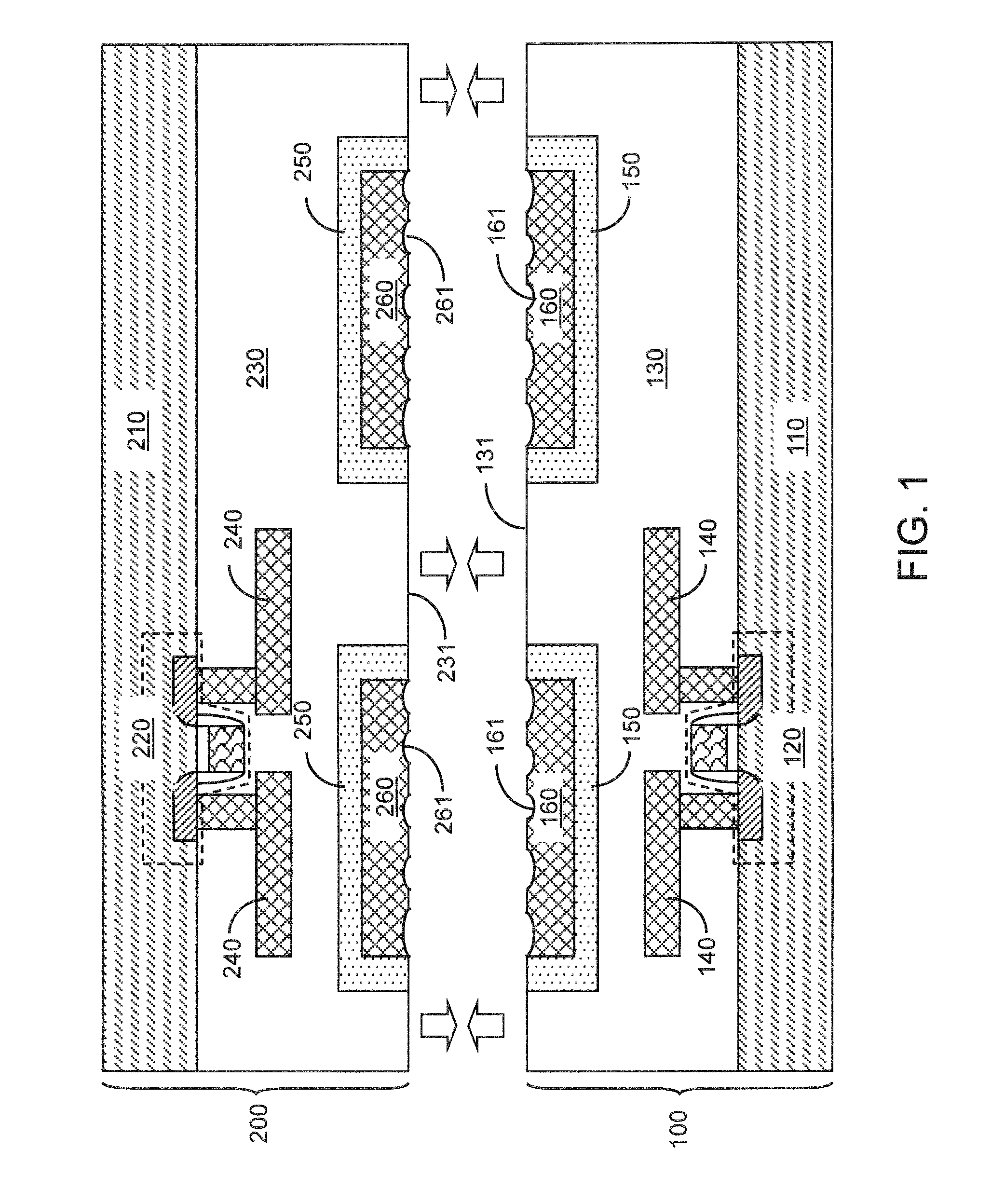Pad bonding employing a self-aligned plated liner for adhesion enhancement
a self-aligned, plated technology, applied in the direction of electrical equipment, semiconductor devices, semiconductor/solid-state device details, etc., can solve the problems of limiting the effectiveness of fusing dielectric materials or grain growth of metal across the original, the temperature of the bonded substrate cannot be raised above a certain limit, and the effect of improving mechanical adhesion
- Summary
- Abstract
- Description
- Claims
- Application Information
AI Technical Summary
Benefits of technology
Problems solved by technology
Method used
Image
Examples
first embodiment
[0028]Referring to FIG. 1, a first exemplary structure according to the present invention includes a first substrate 100 and a second substrate 200 facing each other. The first substrate 100 can include a first semiconductor substrate 110 and at least one first dielectric material layer 130 located thereupon. The second substrate 200 can include a second semiconductor substrate 210 and at least one second dielectric material layer 230 located thereupon. Each of the first and second semiconductor substrates (110, 210), if present, comprises a semiconductor material, which may be selected from, but is not limited to, silicon, germanium, silicon-germanium alloy, silicon carbon alloy, silicon-germanium-carbon alloy, gallium arsenide, indium arsenide, indium phosphide, III-V compound semiconductor materials, II-VI compound semiconductor materials, organic semiconductor materials, and other compound semiconductor materials. For example, the semiconductor material can be silicon. Each of t...
second embodiment
[0049]Referring to FIG. 4, a second exemplary structure according to the present invention includes a first substrate 100 and a second substrate 200, each of which can the same as the first substrate 100 and the second substrate 200, respectively, in the first exemplary structure of FIG. 1 as described above.
[0050]Before the first substrate 100 and the second substrate 200 are brought into physical contact, the first surface(s) 161 of the at least one first metal pad 160 is / are recessed by a recess depth Rd relative to the first dielectric surface 131 of the at least one first dielectric material layer 130. The recess depth Rd can be from 5 nm to 3,000 nm, and typically from 30 nm to 300 nm, although lesser and greater recess depths can also be employed.
[0051]After recessing the first surface(s) 161 of the at least one first metal pad 160, the first substrate 100 and the second substrate 200 are brought into physical contact with each other in the same manner as in the first embodim...
third embodiment
[0059]Referring to FIG. 7, a third exemplary structure according to the present invention includes a first substrate 100 and a second substrate 200, each of which can the same as the first substrate 100 and the second substrate 200, respectively, in the first exemplary structure of FIG. 1 as described above.
[0060]Before the first substrate 100 and the second substrate 200 are brought into physical contact, the first surface(s) 161 of the at least one first metal pad 160 is / are recessed by a recess depth Rd relative to the first dielectric surface 131 of the at least one first dielectric material layer 130 as in the second embodiment. In addition, before the first substrate 100 and the second substrate 200 are brought together, the second surface(s) 261 of the at least one second metal pad 260 is / are recessed by another recess depth Rd′ relative to the second dielectric surface 231 of the at least one second dielectric material layer 230. The recess depths Rd and Rd′ can be from 5 nm...
PUM
| Property | Measurement | Unit |
|---|---|---|
| temperature | aaaaa | aaaaa |
| surface height | aaaaa | aaaaa |
| surface height | aaaaa | aaaaa |
Abstract
Description
Claims
Application Information
 Login to View More
Login to View More - R&D
- Intellectual Property
- Life Sciences
- Materials
- Tech Scout
- Unparalleled Data Quality
- Higher Quality Content
- 60% Fewer Hallucinations
Browse by: Latest US Patents, China's latest patents, Technical Efficacy Thesaurus, Application Domain, Technology Topic, Popular Technical Reports.
© 2025 PatSnap. All rights reserved.Legal|Privacy policy|Modern Slavery Act Transparency Statement|Sitemap|About US| Contact US: help@patsnap.com



